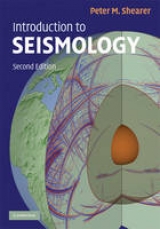
Introduction to Seismology
Seiten
1999
Cambridge University Press (Verlag)
978-0-521-66023-5 (ISBN)
Cambridge University Press (Verlag)
978-0-521-66023-5 (ISBN)
- Titel erscheint in neuer Auflage
- Artikel merken
Zu diesem Artikel existiert eine Nachauflage
An approachable and concise introduction to seismology for upper-division undergraduates or first-year graduate students. It clearly explains the fundamental concepts, emphasizing intuitive understanding over lengthy derivations. Detailed exercises are provided, and in several cases are illustrated with computer subroutines.
This book provides an approachable and concise introduction to seismology theory. It clearly explains the fundamental concepts, emphasizing intuitive understanding over lengthy derivations. Topics include all that is needed for a comprehensive first course in seismology: stress/strain theory, seismic wave equation, ray theory, tomography, reflection seismology, surface waves, source theory, anisotropy and earthquake prediction. Detailed exercises follow each chapter, giving students the opportunity to apply the techniques they have learned to compute results of interest and to illustrate some of Earth's seismic properties. In several cases, computer subroutines are provided to assist with these exercises. Numerous illustrations accompany the text, including examples of seismograms and images of the global seismic wavefield. This textbook is ideal for any introductory course in seismology taught to upper-division undergraduates or first-year graduate students, and is especially suited for a one-semester class on seismology.
This book provides an approachable and concise introduction to seismology theory. It clearly explains the fundamental concepts, emphasizing intuitive understanding over lengthy derivations. Topics include all that is needed for a comprehensive first course in seismology: stress/strain theory, seismic wave equation, ray theory, tomography, reflection seismology, surface waves, source theory, anisotropy and earthquake prediction. Detailed exercises follow each chapter, giving students the opportunity to apply the techniques they have learned to compute results of interest and to illustrate some of Earth's seismic properties. In several cases, computer subroutines are provided to assist with these exercises. Numerous illustrations accompany the text, including examples of seismograms and images of the global seismic wavefield. This textbook is ideal for any introductory course in seismology taught to upper-division undergraduates or first-year graduate students, and is especially suited for a one-semester class on seismology.
Preface; Acknowledgement; 1. Introduction; 2. Stress and strain; 3. The seismic wave equation; 4. Ray theory: travel times; 5. Inversion of travel time data; 6. Ray theory: amplitude and phase; 7. Reflection seismology; 8. Surface waves; 9. Source theory; 10. Earthquake prediction; 11. Miscellanea; Appendices; References; Index.
| Erscheint lt. Verlag | 28.9.1999 |
|---|---|
| Zusatzinfo | Worked examples or Exercises; 8 Tables, unspecified; 136 Line drawings, unspecified |
| Verlagsort | Cambridge |
| Sprache | englisch |
| Maße | 185 x 261 mm |
| Gewicht | 757 g |
| Themenwelt | Naturwissenschaften ► Geowissenschaften ► Geologie |
| Naturwissenschaften ► Geowissenschaften ► Geophysik | |
| ISBN-10 | 0-521-66023-8 / 0521660238 |
| ISBN-13 | 978-0-521-66023-5 / 9780521660235 |
| Zustand | Neuware |
| Haben Sie eine Frage zum Produkt? |
Mehr entdecken
aus dem Bereich
aus dem Bereich



